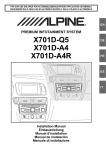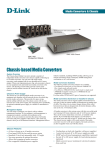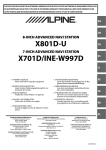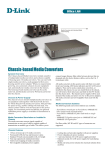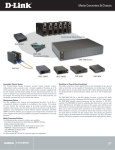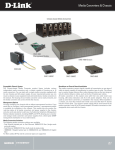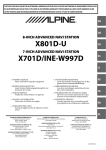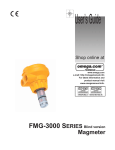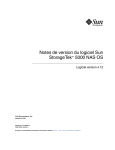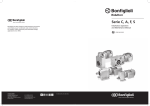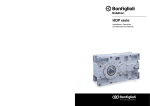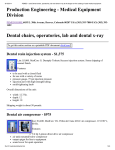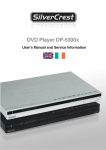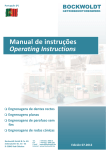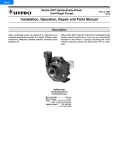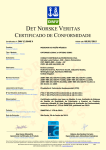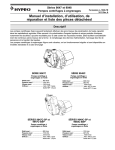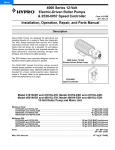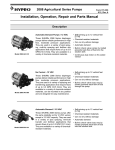Download 5300C-X Series - Dultmeier Sales
Transcript
Series 5300C-X, 5321C, 5322C and 5324C ® Small Twin Piston and Plunger Pumps Form L-0200P 6/11, Rev. B Installation, Operation, Repair And Parts Manual Description SERIES 5300C-X SERIES 5321C & 5322C Max. Flow Rate: ..................1.5, 2.0, 2.5 and 3.0 gpm Max. Pressure: ..........................500 psi Max. Speed: ............................1725 rpm Ports: ................................1/2" NPT inlet 1/2" NPT outlet Max. Operating Temp.................140o F Max. Flow Rate: ........................2.2 gpm Max. Pressure: ........................1000 psi Max. Speed: ............................1725 rpm Ports: ................................1/2" NPT inlet Cast Iron Small Twin Piston Pump Cast Iron Small Twin Plunger Pump 1/2" NPT outlet Max. Operating Temp.................180o F SERIES 5324C Cast Iron Small Twin Piston Pump Max. Flow Rate: ........................2.9 gpm Max. Pressure: ..........................800 psi Max. Speed: ............................1725 rpm Ports: ................................1/2" NPT inlet 1/2" NPT outlet Max. Operating Temp.................140o F Safety Information The following special attention notices are used to notify and advise the user of this product of procedures that may be dangerous to the user or result in damage to the product. NOTE: Notes are used to notify of installation, operation, or maintenance information that is important but not safety related. CAUTION: Caution is used to indicate the presence of a hazard, which will or can cause minor injury or property damage if the notice is ignored. WARNING: Warning denotes that a potential hazard exists and indicates procedures that must be followed exactly to either eliminate or reduce the hazard, and to avoid serious personal injury, or prevent future safety problems with the product. DANGER: Danger is used to indicate the presence of a hazard that will result in severe personal injury, death, or property damage if the notice is ignored. DANGER: DO NOT pump flammable or explosive fluids such as gasoline, fuel oil, kerosene, etc. DO NOT use in explosive atmospheres. The pump should be used only with liquids compatible with the pump component materials. Failure to follow this warning can result in personal injury and/or property damage and will void the product warranty. A pressure relief device, such as an unloader, relief valve or balancing regulator must be installed on the outlet side of the pump. Failure to do so could result in personal injury and/or void the warranty. • • Be sure all exposed moving parts such as shafts, couplers and adapters are properly shielded or guarded and that all coupling devices are securely attached before applying power. Hollow shaft pumps mounted directly onto power shaft must be prevented from rotating with the power shaft by means of a device such as a torque arm. Pump must float freely on the power shaft and must not be tied rigidly to equipment on which it is mounted. • Do not exceed recommended speed, pressure and temperature for pump and equipment being used. • Before servicing, disconnect all power, make sure all pressure in the system is relieved, drain all liquids from the system and flush. • Secure the discharge lines before starting the pump. An unsecured line may whip, causing personal injury and/or property damage. • Check hose for weak or worn condition before each use. Make certain that all connections are tight and secure. • Periodically inspect the pump and the system components. Perform routine maintenance as required (see Maintenance section). • Protect pump from freezing conditions by draining liquid and pumping rust inhibiting solution, such as antifreeze, through the system, coating the pump interior. • Use only pipe, hose and fittings rated for the maximum (or greater) PSI rating of the pump. • Do not use these pumps for pumping water or other liquids for human or animal consumption. Drive Source Installation This manual will cover the installation of the basic drive configurations available for the Hypro Small Twin Piston and Plunger pumps. Consult the manufacturer of your motor or engine for additional information. Read all instructions and general safety information before attempting to install or operate the pump. Belt/Pulley Drive Installation Mounting Belts and Pulleys Mount pulleys as close to pump and motor engine shaft bearings as possible. Check alignment with a straight edge as shown (See Figure 1). Make sure that belt has proper tension. (Too much tension will cause bearing wear; too little will cause slippage.) (See Figure 2). Check with belt and pulley sources for specific recommendation. To figure proper diameter of pump pulley, multiply motor/engine RPM by diameter of the motor/engine pulley and divide that figure by desired pump speed. Pump Pulley Size = Motor RPM x Motor Pulley Size Desired Pump Speed Refer to pump performance charts to determine desired speed to obtain desired maximum flow. NOTE: Shaft rotation can be either clockwise or counterclockwise. Four points of contact indicate alignment. NOTE: Pump may be mounted in other orientations with respect to the motor or engine. Figure 1 Push the belt midway between the pulleys, check the deflection (d) and adjust: d = 0.016 x L Figure 2 d L Direct Drive - Flexible Coupling Installation First, slide coupling ends onto motor/engine and pump shafts as far as possible (See Figure 3). Mount motor/engine and pump onto base, shimming pump or power unit so that shafts are aligned. Leave enough space between ends of shafts to allow coupling disc to be inserted. When alignment is made, slide coupling ends over coupling disc. Leave clearance between coupling ends and center disc. Tighten screws in both coupling ends. For electric motor drive, use couplings rated at least twice the horsepower required to operate pump. For gas engine drive, select couplings rated at three times the required pump horsepower. Form L-0200P (6/11, Rev. B) -2- CAUTION: Figure 3 For safety, always install a shield over rotating shafts and couplings. Direct Drive - Hollow Shaft Installation Hollow shaft models mount directly on the motor or engine shaft (See Figure 4). Adapters are available to convert some solid shaft models for direct shaft mounting. After mounting the pump, always turn it by hand to make sure the pump is operating freely. Never apply power to a pump that appears to be stuck. CAUTION: CAUTION: Use a torque arm to keep the pump from rotating with the shaft. The pump must be allowed to float on the shaft and must not be tied rigidly to the equipment on which it is mounted. For safety, always install a shield over rotating shafts. Or enclose the pump/motor assembly inside a housing. Figure 4 System Installation Pulsation Dampener Inlet Pressure Regulator Line Strainer Compound Gauge Spray Gun IN Figure 5 Filled Pressure Gauge Pump Nozzle OUT Bypass Back to Inlet Piston Pump Installation pressure required of pump. Example: If required pump pressure is 200 psi, use discharge hose rated at minimum of 300 psi working pressure. Accessories should be installed with solid piping and be mounted as close to the pump as possible. The hose must be used right after accessories. Unloader Valve The unloader has a very important safety function in your piston pump hookup. The unloader valve protects the pump by unloading pressure when the gun is shut off or discharge is otherwise blocked. This saves the pump and power because the liquid is bypassed at a very low pressure. If the gun is to be shut off for more than 5 minutes, install a pump protector in the inlet side or stop the pump to prevent heat buildup. The length of time may vary due to the original temperature of the fluid being pumped. NOTE: If remaining installation is solid piping, a two to four foot length of hose must be installed between accessories and solid piping. Hose Selection of the right size and type of hose is vital for good performance. Be sure to hook up to the proper ports on the pump (note markings “IN” and “OUT” on pump castings). Suction Hose Strainers Always use genuine suction hose compatible with the fluids being pumped and at least the same inside diameter as pump ports. If the suction hose is over 5 feet long, use the next larger size hose. Keep the suction hose as short as possible and restrictions such as elbows, check valves, etc. at a minimum. Use a suction line strainer with at least 3 to 5 times the suction port area in open screen area. For example, an area of approximately 1.1 to 1.9 square inches for a 1/2" suction port. Be sure the screen is suitable for the liquid being pumped. Keep the filter clean. A clogged strainer will cause cavitation, which usually leads to a poor performance and wear of the pump parts. Discharge Hose High pressure pumps require the use of special high pressure discharge hose (2 rayon braid or equivalent). Use a hose rated at least 50% greater than the highest operating Unloader Valve -3- Form L-0200P (6/11, Rev. B) Compound Gauge (Optional) The pump should not be subjected to high suction line vacuums. To check on this, install a compound gauge at pump inlet. For ultimate performance and life, the vacuum should be limited to 5 inches of mercury. High vacuum conditions may cause premature product failure and void warranty. Pulsation Dampener This device absorbs the shock and smooths out the pump discharge pulsations, providing smoother operation. For the proper operation of many unloader valves, the pulsation dampener should be installed on the discharge side downstream from the unloader valve. However, for maximum system protection, the pulsation dampener may be installed upstream from the unloader valve, provided the unloader valve will function properly. The dampener can be mounted vertically or horizontally. Pressure Regulator Use a pressure regulator to limit incoming pressure to 20 psi when equipped with a suction side injector. Volume, pressure and horsepower figures in pump performance tables do not apply when incoming pressure exceeds 40 psi. Pressure Gauge/Dampener Use gauge capable of reading double the pump working pressure. Use a silicone-filled gauge or a gauge dampener to protect the gauge needle against pressure surges and provide easier reading. Operation Priming While this flushing is not absolutely necessary for short periods of idleness (as overnight), it is good practice to clean the pump after each use to prevent deposits from forming and damaging the pump. The antifreeze not only coats the interior of the pump with an inhibitor, but acts as a lubricant as well, keeping valves from sticking - and protecting against any remaining moisture freezing in cold weather. If the liquid is below level of the pump, some means should be provided in installation to prime pump, such as a foot valve or check valve to hold prime. Keep suction lift to minimum and avoid unnecessary bends in the suction line. Before starting pump, make sure air bleeder valve or spray gun is open, or unloader valve is adjusted to its lowest pressure. After starting pump, open and close gun several times if necessary to aid priming the pump. If pump does not prime within a few seconds, stop motor and inspect installation for suction line leaks or obstructions. Make sure that strainer is not clogged. Be sure that suction line is not obstructed, kinked or blocked. For infrequent use and before long periods of storage, drain pump thoroughly. Open any drain plugs, remove suction hose from liquid, and run pump “dry” from 0 to 30 seconds (not longer). Once again, a rust inhibitor should be injected into the pump before both ports are plugged and the pump is stored. Then, plug both ports to keep out air until pump is used again. If the pump is to operate hours at a time, check frequently for: Lubrication Schedule 1. Adequate liquid supply. Pump must not run dry for more than 30 seconds. Use a grease gun to lubricate Hypro Series 5300 and 5324 Piston Pumps and Series 5321 and 5322 Plunger Pumps. DO NOT USE AIR-POWERED GREASE GUNS as they develop too much pressure and may cause damage to the sealed cam bearing. 2. Temperature rise. Overheating is harmful to bearings and piston cups. NOTE: Models 53702 and 53703 Inlet Requirements: Pressure feed 20 to 100 psi. Lubrication EXCEPTION: In applications where FDA approval is required, use one of these greases: Chevron FM#2, Mobile FM#2 Keystone (Penwalt Corp.) Nevastane SP Medium. Lubricate every 50 hours or monthly. Care of Pump Your pump will last longer and give best performance when properly taken care of. Proper pump care depends on the liquid being pumped and when pump will be used again. In a normal car wash or detergent cleaning installation (where each application is followed by a clear water rinse), the pump will be kept clean. With a screwdriver or flat tool, apply a generous dab of grease to outer diameter surface of cam bearing at top and bottom where bearing contacts connecting rod. Do not grease excessively. After each use, flush pump with a neutralizing solution for the liquid just pumped. Follow with a clear water rinse. This is especially important for corrosive chemicals. Then flush out pump with a 50% solution of automotive ethylene glycol-type radiator antifreeze containing a rust inhibitor. Form L-0200P (6/11, Rev. B) Check periodically and scrape out (do not WASH out) any excess grease from pump cavity. -4- Repair Instructions Recommended Repair Tools For Hypro Small Twin Piston/Plunger Pumps Ref. Part No. A B C D E F G H I J K L M 1055-0005 3010-0052 3010-0061 3010-0063 3010-0064 3010-0065 3010-0066 3010-0067 3010-0071 3010-0222 3020-0001 3020-0003 3020-0009 Description Seal Ring Seating Tool Valve Cage Extractor Main Bearing Support Tool Cam Bearing Support Tool Support Bars (Qnty 2) Pry Bar Wire Brush Wire Brush Holder Valve Seat Extractor Seal Ring Seating Tool 3/16" Allen Wrench 1/8" Allen Wrench 1/16" Allen Wrench Used for Series 5321 5324 5300 • • • • • • • • • • • • • • • • • • • • • • • Recommended Shop Tools Bench Press, Arbor Press, Air Gun or Electric Hand Drill, Metal Pipe, Support Fixture, (3" diameter x 4 1/2" high), Ratchet Handle Wrench with 9/16" Hex Socket, Bolt (3/8" diameter x 4 1/2" long), No. 320 Grit Emory Cloth, Pliers, Small Knife, Large File, Claw Hammer, Standard Screwdriver, Lubricating Spray (WD-40 or LPS), Wire Brush (hand or machine), Stationary Belt Sander, and Cleaning Solvent Tank (recommended) • • • • • • • • • • • • Inspection of Pump Parts When disassembling pump, thoroughly inspect all parts and replace if necessary, with special consideration given to the following areas: Figure 6 Recommended Repair Tools Figure 7 Use a feeler gauge on this end to check amount of space. 1. Inspect Pump Body for erosion at O-ring seal points in Valve and Piston bores. Check for wear resulting from Main Bearings turning in Housing, especially the Front Bearing area closest to the Cam Bearing. Check for cracks in the Pump Body, particularly at the discharge port and along the casting seam (See Figure 7). 2. Inspect for excessive wear on the Cylinder Heads. This can result from erosion and/or valve seat hammer (See Figure 7). Figure 8 3. Inspect for pitting and general wear in the Unitized Valves, particularly where the Poppets seal against the seat. If this area is worn, replace all four Valves (See Figure 7). Check this area for wear on both ends. 5. Inspect Crankshaft Assembly for general wear. Rotate Cam Bearing and Main Bearings to check for roughness due to moisture contamination or lack of grease. If main bearings do not turn smoothly or appear to be damaged, they should be replaced. If cam bearing is damaged, a new Crankshaft Sub-assembly should be installed and the connecting rod inspected for wear (See Figure 8). 4. Inspect the Connecting Rod. If there is more than .007" wear in the total space between the Connecting Rod and Cam Bearing, the Connecting Rod should be replaced. This can be determined using a feeler gauge. The Cam Bearing should also be inspected as a bad cam bearing is the most common cause of a damaged Connecting Rod. A worn Connecting Rod results in low volume, low pressure, a hammering sound and the pump running hot (See Figure 8). NOTE: Always use new O-rings, Cups, Seal Rings, Support Rings, Guides, Washers, and Piston Cap Screws. If new Valves are needed, always replace the complete set of four. -5- Form L-0200P (6/11, Rev. B) Series 5300X, 5321, 5322, & 5324 Disassembly, Repair, & Reassembly Instructions NOTE: Due to variations in each model's Piston or Plunger Stack, differences in the instructions for each model will be denoted with italics and brackets. 6. Turn the Pump over and repeat Steps 1 through 5. HAZARDOUS SUBSTANCE ALERT: Always drain and flush pump before servicing or disassembly. 8. Use a claw hammer to remove the Grease fitting (See Figure 11). In most cases, the Grease Fitting is damaged during removal and must be replaced [At this time, remove the Connecting Rod in Models 5321 & 5322]. 7. Position the Pump horizontally in the vise with the Safety Cover side up. Valve Assembly Removal: 1. Place the Pump upright in a bench-mounted vise with the Safety Cover facing out; then, using a 9/16" wrench, remove the Cylinder Head Bolts. 2. Remove the Cylinder Head. 3. Using a screwdriver or knife, remove the Cylinder Head O-ring from the Cylinder Head. 4. Using the Seat and Cage End Valve Extraction Tools, remove the Unitized Valve Assembly from the Pump Body (See Figures 9 and 10). Figure 11 Piston Sleeve Assembly Removal and Cleanup (5300X and 5324 only) See Figures 12 & 13 for Piston Stack Components To remove Valve Cage. Hook prongs of Valve Cage Extractor under three webs of the Valve Cage and pull up with a twisting motion. Cap Screw Figure 9 Cup Washer O-ring Cup Spreader Cup Backing Plate O-ring Seal Ring Guide To remove Valve Seat. Hook Valve Seat Extractor under Seat and work out with an up and down motion. Figure 12 Cap Screw Washer Cup Support Ring Figure 10 5. Rotate the Pump Shaft so the Cam Bearing is in the upstroke position; then using a 3/16’’ Allen wrench, remove the Cap Screw from the Piston Assembly for Models 5300X and 5324 [For Models 5321 & 5322, remove the Plunger from the Pump Body after the Cap Screw is removed]. Form L-0200P (6/11, Rev. B) O-ring Seal Ring Guide Figure 13 -6- Cup Holder 1. Leave the pump body horizontal in the bench vise to remove the Cylinder Sleeves and Piston Assemblies. Make sure the Cam Bearing is in the upstroke position. Place one of the metal bars provided in the tool kit on the Cylinder Sleeve. 3. Place a bolt 3/8" in diameter by 4-1/2" long threaded end up on the Crankshaft Cam Bearing; then, using the arbor press ram on the bolt, push the Crankshaft Assembly out of the Pump Body (See Figure 14). Plunger Cartridge Removal/Disassembly/ Reassembly (Series 5321 and 5322 only) 2. Using a hammer, gently tap the Cylinder Sleeve out of the Cylinder Head end of the pump body. The Piston will also come out with the Cylinder sleeve. See Figure 15 for Plunger Cartridge Components 3. Turn the pump around in the vise and repeat Steps 1 and 2. Cap Screw Support Ring (Brass) Inner Support Ring O-ring 4. Remove the Connecting Rod. Washer O-ring 5. Remove the Piston Assembly from the Cylinder Sleeve by pushing it out with your fingers; then remove the washer. Seal Ring Guide Seal Seal Retainer (Brass) Guide Retainer (Brass) 6. Clean the cylinder sleeves using the burnishing adapter supplied with the tool kit. The adapter is mounted to an electric motor shaft. Insert the Cylinder Sleeve (brass retainer end facing out) into the furnishing adapter and polish the inside surface using a No. 320 grit emery cloth. Use a wire brush to clean the outside of the cylinder sleeve. Upon inspection, if pitting or scratches still show on the inside of the cylinder sleeve, the cylinder sleeve must be replaced along with the cylinder sleeve o-ring. Plunger: Steel (5321), Ceramic (5322) Washer (5322 ONLY) Figure 15 To Remove the Plunger Cartridges from the Pump Body: 1. Position the pump upright on the arbor press with the Safety Cover opening facing out. 2. Place the Plunger Cartridge Extractor Tool, machined side down, on the Guide Retainer inside the pump body. Crankshaft Assembly Removal (All Models) 3. Place the bolt threaded-end down through the Plunger Bore on the other end of the pump until it rests in the counter-sink hole on the Cartridge Extractor Tool. WARNING: Special attention should be exercised when working with retaining rings. Always wear safety goggles when working with spring or tension-loaded fasteners or devices. 4. Place the arbor press ram on the bolt head and push both the Seal and Guide Retainer out of the pump body (See Figure 16). 1. Place the pump on a flat surface with the shaft side facing up; then remove the retaining ring from the bearing bore. 5. Turn the pump over and repeat Steps 1 through 4. 2. Using a metal pipe 3" in diameter by 4-1/2" high as a support fixture, place the pump on the fixture, shaft side down. Position the fixture with pump on the arbor press (See Figure 14). Figure 14 Figure 16 -7- Form L-0200P (6/11, Rev. B) To Disassemble the Guide and Seal Cartridges: Clean-up of the Pump Body and Heads (All Models) 1. Remove the Guide from the Guide Retainer by pulling it out with one finger. 1. Using the port wire brush with an air gun or electric hand drill, clean the outlet port and inlet port, plus the valve and piston bores in the Pump Body. NOTE: If the guide does not come out in this manner, use a screwdriver and a hammer to gently break off a section of the Guide, being careful not to damage the Guide Retainer. The remaining portion of the Guide will then fall out. 2. Use a hand file or belt sander to clean corrosion and rust from the top and bottom of the Pump Body and the bottoms of the cylinder Heads. 3. After performing Steps 1 and 2, Hypro recommends that the pump Body and Cylinder Head be further cleaned in a solvent tank to remove any remaining rust and corrosion particles. 2. With a small knife blade, remove the O-ring/Seal Ring combination from the Guide Retainer. 3. Using a small knife blade, remove the Brass Support Ring and Support Ring/Seal combination from the Seal Retainer. NOTE: If the solvent cleaning is not performed, the valve and piston bores must be wiped as clean as possible. 4. Inspect and clean the Brass Guide and Seal Retainers. Clean them with a wire brush and check them for burrs and nicks. Use 320 grit emery cloth to remove burrs. Crankshaft and Main Bearing Disassembly/Reassembly (All Models) Disassembly: To Reassemble the Plunger Cartridges: 1. To remove the Front Main Bearing from the Crankshaft, position a pipe support fixture on the arbor press; then, place two metal bars parallel to each other, one on each side of the fixture (See Figure 17). 1. Lightly lubricate the O-ring and place it around the Seal Ring. 2. Position the O-ring/Seal Ring combination in the Guide Retainer at a 45 degree angle. 2. Place the Crankshaft Assembly in the fixture, drive end up, with the metal bars between the Bearing and fixture to support the Outer Bearing (See Figure 17). 3. Using the Guide, seat the O-ring/Seal Ring Combination into the Guide Retainer, leaving the Guide in the Guide Retainer. 4. Place the Guide Retainer on a flat surface so that the exposed portion of the Guide is down. NOTE: Make sure the metal bars do not touch the Retaining Ring on the Crankshaft. 5. Place the cap screw end of the Plunger into the Guide Retainer and press it through until the Plunger is flush with the bottom of the Guide Retainer. 3. Using the arbor press, press the Crankshaft through the Bearing (See Figure 17). WARNING: Special attention should be exercised when working with retaining rings. Always wear safety goggles when working with spring or tension- loaded fasteners or devices. 6. Turn the Cartridge over and push the Guide Retainer down the Plunger until it is flush with the bottom of the Plunger. Seal Retainer Cartridge: 1. Place the beveled side of the Inner Support Ring in the grooved side of the Seal; then, place the Seal Retainer over the Support Ring side of the Support Ring/Seal combination. 2. Press the above items in with your fingers until the Support Ring/Seal combination bottoms out inside the Seal Retainer. 3. Place the Brass Support Ring on the open side of the Seal Retainer. Form L-0200P (6/11, Rev. B) Figure 17 -8- 10. Turn the Pump and Main Bearing Support Tool over so that the Safety Cover side of the pump is facing up. 4. Remove the first Retaining Ring on the Crankshaft with a pliers and the second Retaining Ring with a screwdriver. 5. Press out the back Main Bearing in the same manner as the front Main Bearing (Refer to Steps 1 through 3). 11. Position the Cam Bearing Support Tool with the bolt head down over the Safety Cover opening on the pump body. 6. Remove the Slinger Ring by working it off the Shaft. Reassembly 1. Install the back Main Bearing first. Place the Bearing on the small opening end of the Main Bearing Support Tool with the Slinger Ring on top of the Bearing, and position it on the arbor press. Figure 19 WARNING: Special attention should be exercised when working with retaining rings. Always wear safety goggles when working with spring or tension-loaded fasteners or devices. 12. Turn the bolt down by hand until it comes in contact with the Cam Bearing. 13. Use the arbor press ram to press down on the bolt in the Cam Bearing Support Tool to push the front Main Bearing into the pump bearing bore until it comes in contact with the first retaining ring on the crankshaft. 2. Place the Crankshaft in the Bearing and use the arbor press ram to press the Crankshaft through the Bearing until the Retaining Ring can be installed in the second groove of the Crankshaft (See Figure 18). 14. Turn the pump over to install the Retaining Ring in the pump bearing bore. NOTE: Make sure the Slinger Ring does not touch the Cam Bearing on the Crankshaft when installing Retaining Rings. Valve Assembly Installation 3. Install both Retaining Rings on the Crankshaft. 1. Lubricate the Pump Body Valve Bores. 2. Install the Valve Assemblies into the INLET side valve bores with the plastic valve cage portion facing UP (See Figure 20). 3. Install the Valve Assemblies into the OUTLET side valve bores with the metal valve seat portion facing UP (See Figure 21). Figure 18 4. Apply a small amount of grease to the top and bottom inside surfaces of the Connecting Rod. (The area where the Cam Bearing comes in contact with the Connecting Rod.) 4. Place the Pump Body, Safety Cover side down, on the arbor press. 5. Place the Crankshaft, Back Bearing down, into the bearing bore of the Pump Body. Plastic Valve Cage points Up. 6. Place the Main Bearing Support Tool , large opening down, over the Crankshaft. 7. Use the arbor press ram to press the Crankshaft Assembly into the bearing bore of the pump body until it bottoms out. 8. Place the front Main Bearing on the Crankshaft until it touches the pump body. Figure 20 9. Place the smaller opening end of the Main Bearing Support Tool over the Crankshaft (See Figure 19). 5. Place the Connecting Rod on the Cam Bearing. -9- Form L-0200P (6/11, Rev. B) Metal Valve Seat Points up. 11. Lubricate the O-ring and install it on the Cup Spreader. 12. Place the Cup Spreader end opposite O-ring in the Cup inside the piston bore. 13. Place the Washer on the Piston Cap Screw, insert it through the Piston Assembly, then tighten it to 130 in. lbs. of torque. Figure 21 Cylinder Sleeve and Piston Stack Installation (Series 5300X and 5324 only) NOTE: Clean the cylinder sleeves using the Burnishing Adapter provided with the tool kit. The Burnishing Adapter is to be mounted on an electric motor shaft. 1. Insert the Cylinder Sleeve (Brass Retainer End out) into the Burnishing Adapter and polish the inside surface using a No. 320 grit emery cloth. 2. Use a wire brush to clean the outside of the Cylinder Sleeve. NOTE: Upon inspection, if pitting or scratches still show on the inside of the Cylinder Sleeve, the Cylinder Sleeve and the Cylinder Sleeve O-ring should be replaced. 3. Insert the Cylinder Sleeve into the cylinder bore of the Pump Body. 4. Lubricate and place a new Cylinder Sleeve O-ring on top of the Cylinder Sleeve. 5. Place a Brass Retainer on top of the O-ring. 6. Insert the Guide into the Cylinder Sleeve, making sure the Guide is properly seated on the Connecting Rod inside the Pump Body. 7. Place the Seal Ring at a 45 degree angle on top of the Guide; then, using the Seal Ring Seating Tool, press the Seal Ring into the Cylinder sleeve. 8. Lubricate the O-ring and place it on the Cup Backing Plate. 9. Install the Cup Backing Plate on top of the Seal Ring in the piston bore, O-ring end down. 10. Lubricate the Cup and set it on top of the Cup Backing Plate inside the piston bore. Form L-0200P (6/11, Rev. B) 14. Turn the Pump over and repeat Steps 2 through 13. Plunger Assembly Installation (Series 5321 and 5322 only) NOTE: Make sure the Cam Bearing is in the upstroke position when installing the Cylinder Sleeves and Piston Assemblies. 1. Place the assembled Guide Retainer Cartridge and Plunger into the plunger bore of the Pump body, making sure the Plunger and Connecting Rod seat together properly inside the Pump Body. 2. Lubricate the O-ring and place it on top of the Guide Retainer Cartridge. 3. Place the Seal Retainer Cartridge over the Plunger (beveled side down), and press it by hand into the Pump Plunger bore. 4. Place a Washer on the Plunger Cap Screw, insert it through the Plunger and tighten it to 100 to 115 In. Lbs. of torque. 5. Turn the Pump over and repeat Steps 1 through 4. Head and Grease Fitting Installation (All Models) 1. Install the O-ring into the Pump Cylinder head. 2. Place the Pump Body upright in a vise; then, place the Head on the Pump Body. 3. Secure the head to the Pump Body with the Head Bolts; then, alternately and evenly (in a criss-cross pattern) tighten the head Bolts. 4. Turn the Pump over and repeat Steps 1 through 3. 5. To install the Grease Fitting into the Cam Bearing, place the pump on the arbor press with the Safety Cover side facing up; then press the Grease Fitting in with the arbor press ram. 6. Grease the pump according to the Lubrication Instructions. 7. Install the safety cover. -10- Troubleshooting Symptom Probable Cause(s) Corrective Action(s) No Flow or Low Flow Pump not primed Refer to Priming in the Operation Section. Blocked or clogged line strainer Inspect strainer and clear any debris from screen. Air leaks in suction line Check and reseal inlet fittings. Undersize suction line or collapsed hose Suction line should be the same diameter as inlet port of Pump or larger. Nozzle clogged Clear nozzle or replace. Debris in Valves Remove debris. See Repair section. Unloader or Relief Valve not functioning properly Repair or replace relief valve. Unloader or Relief Valve not functioning properly Low pressure Valves worn Pump Leaking Repair or replace Relief Valve. Replace Valves. See Repair section. Pump not primed See priming in Operation section. Body cracked Replace Body. See Repair section. Seals worn Replace Seals. See Repair section. Performance Data Series 53702 Series 53703 Series 5300C-X NOTE: Above performance figures based on constant speed dynamometer tests, pumping water at one foot (approx.) suction lift with no pulsation damper. Performance will vary with application. Series 5321C and 5322C 7 BAR 20 BAR 4 0 BA R 5 0 BA R 69 BAR RP M L/min. W L/min. W L/min. W L/min. W L/min. W 900 4.2 165 4.2 261 4.2 399 4.2 461 4.1 575 1200 5.8 224 5.6 357 5.5 536 5.5 603 5.4 739 1450 6.9 269 6.8 399 6.7 601 6.7 700 6.6 888 1725 8.2 321 8.1 459 8.0 692 8.0 815 7.9 1059 Series 5324C 100 psi RPM 600 900 1200 1450 1725 GPM .96 1.51 2.00 2.42 2.90 HP .12 .19 .28 .34 .40 200 psi GPM .94 1.49 1.98 2.40 2.89 HP .19 .30 .41 .50 .59 300 psi GPM .94 1.48 1.97 2.38 2.87 HP .26 .41 .55 .67 .80 400 psi GPM .95 1.47 1.96 2.37 2.85 HP .33 .50 .67 .83 1.00 500 psi GPM .94 1.47 1.96 2.36 2.83 HP .3 9 .60 .8 1 .9 7 1.19 600 psi GPM .9 3 1.46 1.95 2.35 2.81 HP .45 .69 .93 1.13 1.38 700 psi GPM .93 1.46 1.94 2.33 2.80 HP .52 .78 1.06 1.27 1.54 800 psi GPM .93 1.45 1.93 2.32 2.79 -11- HP .58 .87 1.16 1.42 1.69 7 BAR 21 BAR 34.5 BAR 48 BAR 55 BAR RPM L/min. W L/min. W L/min. W L/min. W L/min. W 900 5.7 200 5.7 300 5.7 500 5.7 60 0 5.7 70 0 1200 7.6 200 7.6 500 7.6 600 7.2 80 0 7.2 90 0 1450 9.1 300 9.1 500 9.1 800 8.7 1000 8.7 1100 1725 11.0 300 11.0 600 10.6 900 10.6 1200 10.6 1300 Form L-0200P (6/11, Rev. B) Models 5315C-X, 5320C-X, 5325C-X and 5330C-X NOTE: When ordering parts, give QUANTITY, PART NUMBER, DESCRIPTION, and COMPLETE MODEL NUMBER. Reference numbers are used ONLY to identify parts in the drawing and are NOT to be used as order numbers. Piston Stack Parts Kit Leather Cup Kit No. 3430-0007 Consists of two each of the following parts: No. 2220-0012 Piston Cap Screw (Ref. 6A), No. 22700011 Washer (Ref. 6B), No. 1720-0029 O-ring (Ref. 6C), No. 2150-0002 Leather Cup (Ref. 6D), No. 1720-0039 O-Ring (Ref. 6E), and No. 1440-0008 Seal Ring (Ref. 6F). 17 18 19 6A 6B 6C 2 3 4 6 12 6D 5 6E 6F 7 8 13 10 15 Piston Stack and Guide Parts Kits A B C D E A B 20 C 21 14 Rubber Cup Kit No. 3430-0009 Same as above kit except with No. 2150-0005 Rubber Cups. Leather Cup and Guide Kit No. 3430-0008 Consists of Leather Cup Kit No. 3430-0007 plus two No. 1440-0004 Piston Guides (Ref. 7). Rubber Cup and Guide Kit No. 3430-0010 Consists of Rubber Cup Kit No. 3430-0009 plus two No. 1440-0004 Piston Guides. Teflon Cup and Guide Kit No. 3430-0046 Consists of Teflon Cup Stack Kit plus 2 Piston Guides. 16 24 25 22 9 26 25 27 Sub-Assembly Part No. 28 17 2 3 4 5 6 7 8 9 10 12 2 2 2 2 1 2 1 1 1 1 13 14 15 2 1 1 16 17 18 19 20 1 8 2 2 1 2220-0012 2270-0011 1830-0017 1410-0030 Sub-Assemblies include Shaft (Ref. 12 or 15) with Cam Bearing, Grease Fitting Assembly (Ref. 10), Set Screws for Hollow Shaft (Ref. 13) and Spline Key (Ref. 14 or 16). Complete Assemblies include the Sub-Assembly plus parts identified by Reference Numbers 24-26. 29 Ref. Qty. Part No. Req'd. No. Crankshaft Assemblies Ref. Qty. Part No. Req'd. No. Description Piston Cap Screw Washer Piston Cup Spreader Cup Backing Plate Piston Stack Parts Kit (see listinabove) 1440-0004 Piston Guide 0502-5300 Connecting Rod 0608-5300 Safety Cover 2405-0006 Grease Fitting Assembly Crankshaft Assemblies — Hollow Shaft Models, see listing above 2230-0017 Set Screw for Hollow Shaft 1610-0011 Spline Key for Hollow Shaft Crankshaft Assemblies — Solid Shaft Models, see listing above 1610-0007 Spline Key for Solid Shaft 2210-0062 Cylinder Head Bolt 0204-5300C Cylinder Head (Cast Iron) 1720-0038 O-ring for Cylinder Head 3430-0209 Ni-Resist Cylinder Sleeve Assembly Consists of two each of No. 1830-0033 Retainer (Ref. A), No. 1720-0079 O-ring (Ref. V), and No. 3550-0018 Sleeve (Ref. C) Form L-0200P (6/11, Rev. B) -12- 21 1 set 22 24 25 26 27 28 29 1 1 2 2 1 1 1 Complete Assembly Part No. Pump Model with 5/8" (I.D.) Hollow Shaft (Ref. 12) 5501-5315 5500-5315 5501-5320 5500-5320 5501-5325 5500-5325 5501-5330 5500-5330 5315C-H 5320C-H 5325C-H 5330C-H with 5/8" Solid Shaft (Ref. 15) 5001-5315 5000-5315 5001-5320 5000-5320 5001-5325 5000-5325 5001-5330 5000-5330 5315C 5320C 5325C 5330C 3430-0197 Description Set of four No. 3400-0073 Unitized Valve Assemblies: Consists of four each: O-ring (Ref. A), Valve Seat (Ref. B), Valve Poppet (Ref. C), Valve Spring (Ref. D), Valve Spring Retainer (Ref. E) 0108-5300C Body (Cast Iron) 2130-0007 Bearing Shield 2008-0001 Main Bearing (Ball Bearing) 1810-0013 Bearing Retainer Ring (shaft) 1820-0025 Bearing Retainer Ring (housing) 1510-0056 Mounting Base 2820-0040 Torque Arm - for Electric Motor Mounting Models 5321C and 5322C Plunger Parts Kits Plunger Stack Parts Kit No. 3430-0144 (Model 5321) 5 2 3 4 A B 6 7 8 9 10 11 15 16 17 12 34 A B C 18 D E 19 Consists of two each of the following parts: No. 1440-0010 Seal Rings, No. 1440-0037 Guides, No. 1720-0064 O-rings, No. 1720-0079 O-rings, No. 2150-0027 Seal Assemblies, No. 2220-0039 Socket Head Cap Screws, and No. 2270-0042 Washers. 24 Plunger Parts Kit No. 3430-0145 (Model 5321) Consists of one No. 3430-0144 Plunger Stack Parts Kit and two No. 3500-0021 Plungers. 30 Plunger Stack Parts Kit No. 3430-0291 (Model 5322) Consists of two each of the following parts: No. 1440-0010 Seal Rings, No. 1440-0037 Guides, No. 1720-0064 O-rings, No. 1720-0079 O-rings, No. 2150-0027 Seal Assemblies, No. 2220-0039 Socket Head Cap Screws, and No. 2270-0042 Washers. 22 27 21 13 25 28 29 29 31 Plunger Parts Kit No. 3430-0292 (Model 5322) Consists of one No. 3430-0291 Plunger Stack Parts Kit and two No. 3500-0036 Plungers. 26 Crankshaft Assemblies Solid Shaft Sub-Assembly No. 5001-5321 Consists of one each of the following parts: No. 0500-5321 Crankshaft, No. 1600-0014 Crankpin Retainer, No. 2007-0029 Cam Bearing, No. 2405-0006 Grease Fitting Assembly, and No. 1610-0007 Key. 32 Hollow Shaft Sub-Assembly No. 5501-5321 Consists of one No. 0550-5321 Crankshaft, one No. 2007-0029 Cam Bearing, one No. 2405-0006 Grease Fitting Assembly, one No. 16100011 Key, and two No. 2230-0017 Set Screws. 15A 33 Hollow Shaft Assembly No. 5500-5321 Consists of one No. 5501-5321 Crankshaft Sub-Assembly, two No. 1810-0013 Retaining Rings, two No. 2008-0001 Main Bearings, and one No. 2130-0007 Bearing Shield. Ref. No. Qty. Part Req'd. No. 2 3 4 5 2 2 2 2 6 7 8 9 10 11 12 12 13 13 14 15 2 2 2 2 2 2 2 2 1 1 1 * 15A 4 16 17 2 2 Description 2220-0039 2270-0042 1830-0056 2150-0027 Socket Head Cap Screw Washer Retainer Seal Assembly: Consists of No. 2150-0049 Seal (Ref. A) and No. 1440-0061 Support Ring (Ref. B) 1830-0054 Seal Retainer 1720-0079 O-ring for Seal Retainer 1440-0037 Guide 1720-0064 O-ring for Seal Ring 1440-0010 Seal Ring 1830-0053 Guide Retainer 3500-0021 Plunger (steel, Model 5321) 3500-0036 Plunger (ceramic, Model 5322) 0502-5300 Connecting Rod (Model 5321) 0504-5300 Connecting Rod (Model 5322) 0608-5300 Safety Cover 2210-0063 Cylinder Head Bolt (8 bolts required for Model 5321C-H Hollow Shaft Pump; 4 bolts required for Top Cylinder Head ONLY on Solid Shaft Pumps) 2210-0064 Extra Long Cylinder Head Bolt for securing mounting base to Solid Shaft Models 0201-5300C Cylinder Head (Cast Iron) 1720-0038 O-ring for Cylinder Head -13- Ref. No. Qty. Part Req'd. No. 18 1 set 19 21 22 1 1 1 24 25 26 2 1 1 27 28 29 30 31 32 33 1 1 2 2 1 1 1 1610-0007 2130-0007 2008-0001 1810-0013 1820-0025 1510-0041 3420-0030 34 2 2270-0097 Description 3430-0197 Set of four No. 3400-0073 Unitized Valve Assemblies: Consists of four each: O-ring (Ref. A), Valve Seat (Ref. B), Valve Poppet (Ref. C), Valve Spring (Ref. D), and Valve Spring Retainer (Ref. E) 0108-5300C Body (Cast Iron) 2405-0006 Grease Fitting Hollow Shaft Sub-Assembly (see listing above) 2230-0017 Set Screws for Hollow Shaft 1610-0011 Spline Key for Hollow Shaft Solid Shaft Sub-Assembly (see listing above) Spline Key for Solid Shaft Shield Main Bearing Retaining Ring (shaft) Retaining Ring (housing) Mounting Base for Solid Shaft Models Torque Arm Kit for Hollow Shaft Models - Consists of No. 2820-0035 Torque Arm, No. 1450-0003 Bumper and two No. 2210-0064 Bolts Washer (Model 5322 only) Form L-0200P (6/11, Rev. B) Spec Pumps 53702 and 53703 5 14 15 2 3 4 A B 6 7 8 9 10 11 16 17 A B C D 24 25 E 18 12 21 13 22 28 Spec Pump No. 53702 30 19 34 Crankshaft Assemblies 29 Hollow Shaft Sub-Assembly No. 5501-5318 29 Consists of one No. 0550-5318 Crankshaft, one No. 2007-0029 Cam Bearing, one No. 2405-0006 Grease Fitting Assembly, one No. 1610-0011 Key, two No. 2230-0017 Set Screws. 31 Hollow Shaft Assembly No. 5500-5318 Consists of one No. 5501-5318 Crankshaft SubAssembly, two No. 1810-0013 Retaining Rings, two No. 2008-0001 Main Bearings, one No. 2130-0007 Bearing Shield. Spec Pump No. 53703 Hollow Shaft Sub-Assembly No. 5501-5320 Consists of one No. 0551-5320 Crankshaft, one No. 2007-0029 Cam Bearing, one No. 2405-0006 Grease Fitting Assembly, one No. 1610-0011 Key, two No. 2230-0017 Set Screws. 33 15A Hollow Shaft Assembly No. 5500-5320 Plunger Parts Kits NOTE: When ordering parts, give QUANTITY, PART NUMBER, DESCRIPTION, and COMPLETE MODEL NUMBER. Reference numbers are used ONLY to identify parts in the drawing and are NOT to be used as order numbers. Ref. No. Qty. Part Req'd. No. 2 3 4 5 2 2 2 2 6 7 8 9 10 11 12 13 14 15 15A 2 2 2 2 2 2 2 1 1 8 2 16 17 2 2 Plunger Stack Parts Kit No. 3430-0291 Consists of two each of the following parts: No. 1440-0010-6 Seal Rings, No. 1440-0037 Guides, No. 1720-0064 O-rings, No. 17200079 O-rings, No. 2150-0027 Seal Assemblies, No. 2220-0039 Socket Head Cap Screws, No. 2270-0042 Washers, and No. 2270-0051 Washers. Plunger Parts Kit No. 3430-0292 Consists of one No. 3430-0291 Plunger Stack Parts Kit and two No. 3500-0036 Plungers. Description 2220-0039 2270-0042 1830-0056 2150-0027 Socket Head Cap Screw Washer Retainer Seal Assembly: Consists of one No. 2150-0049 Seal (Ref. A) and one No. 1440-0061 Support Ring (Ref.B) 1830-0054 Seal Retainer 1720-0079 O-ring for Seal Retainer 1440-0037 Guide 1720-0064 O-ring for Seal Ring 1440-0010 Seal Ring 1830-0053 Guide Retainer 3500-0036 Plunger 0504-5300 Connecting Rod 0608-5300 Safety Cover 2210-0063 Cylinder Head Bolt 2210-0064 Extra Long Cylinder Head Bolt for torque arm 0201-5300C Cylinder Head (Cast Iron) 1720-0038 O-ring for Cylinder Head Form L-0200P (6/11, Rev. B) Consists of one No. 5501-5320 Crankshaft SubAssembly, two No. 1810-0013 Retaining Rings, two No. 2008-0001 Main Bearings, one No. 2130-0007 Bearing Shield. -14- Ref. No. Qty. Part Req'd. No. 18 1 Set 19 21 22 1 1 1 24 25 28 29 30 31 33 2 1 1 2 2 1 1 34 2 3430-0197 Description Set of four No. 3400-0073 Unitized Valve Assemblies: Consists of four each: O-ring (Ref. A), Valve Seat (Ref. B), Valve Poppet (Ref. C), Valve Spring (Ref. D), Valve Spring Retainer (Ref. E) 0108-5300C Body (Cast Iron) 2405-0006 Grease Fitting Hollow Shaft Sub-Assembly (See **** listing above for description) 2230-0017 Set Screws for Hollow Shaft 1610-0011 Spline Key for Hollow Shaft 2130-0007 Shield 2008-0001 Main Bearing 1810-0013 Retaining Ring (shaft) 1820-0025 Retaining Ring (housing) 3420-0030 Torque Arm Kit: Includes (1) No. 2820-0035 Torque Arm, (1) No. 1450-0003 Bumper and (2) No. 2210-0064 Bolts. 2270-0097 Washer Models 5324C and 5324C-H Piston Parts Kit 11 Piston Stack Parts Kit No. 3430-0191 12 13 2 3 4 5 A B 14 C 15 16 6 7 8 9 18 A B C D E 19 21 22 27 24 25 Consists of two each of the following parts: No. 2220-0012 Cap Screw (Ref. 2), No. 2270-0011 Washer (Ref. 3), No. 2150-0047 Cup (Ref. 4), No. 1720-0029 O-ring (Ref. 6), No. 1440-0059 Seal Ring (Ref. 7) and No. 1440-0060 Guide (Ref. 8). 26 Crankshaft Assembly Kits 26 28 23 Model 5324C Solid Shaft Sub-Assembly No. 5001-5321 Consists of one each of the following parts: No. 0500-5321 Crankshaft, No. 1600-0014 Crankpin Retainer, No. 2007-0029 Cam Bearing, No. 24050006 Grease Fitting Assembly, No. 1610-0007 Key. Model 5324C-H Hollow Shaft Sub-Assembly No. 5501-5321 Consists of one No. 0550-5321 Crankshaft, one No. 1600-0014 Crankpin Retainer, one No. 2007-0029 Cam Bearing, one No. 2405-0006 Grease Fitting Assembly, one No. 1610-0011 Key, two No. 22300017 Set Screws. 10 Hollow Shaft Assembly No. 5500-5321 29 11A Consists of one No. 5501-5321 Crankshaft SubAssembly, two No. 1810-0013 Retaining Rings, two No. 2008-0001 Main Bearings, one No. 2130-0007 Bearing Shield. 30 Ref. No. 2 3 4 5 6 7 8 9 10 11 Qty. Part Req'd. No. 2 2 2 2 2 2 2 1 1 * 11A 4 12 13 14 2 2 1 2220-0012 2270-0011 2150-0047 1830-0092 1720-0029 1440-0059 1440-0060 0500-5324 0608-5300 2210-0063 Description Piston Cap Screw Washer Cup Cup Holder O-Ring Seal Ring Guide Connecting Rod Safety Cover Cylinder Head Bolt (8 required for Hollow Shaft Pump; 4 required for top cylinder head ONLY on Solid Shaft Pump) 2210-0064 Extra Long Cylinder Head Bolt for securing mounting base to Solid Shaft Pump 0201-5300C Cylinder Head (Cast-Iron) 1720-0038 O-Ring 3430-0210 Ni-Resist Cylinder Sleeve Assembly: Consists of two each of No. 1830-0033 Retainer (Ref. A), No. 1720-0079 O-ring (Ref. B), and No. 3550-0028 Sleeve (Ref. C) -15- Ref. No. Qty. Part Req'd. No. 15 1 set 16 18 19 1 1 1 21 22 23 2 1 1 24 25 26 27 28 29 30 1 1 2 2 1 1 1 3430-0197 Description Set of four No. 3400-0073 Unitized Valve Assemblies: Consists of four each: O-ring (Ref. A), Valve Seat (Ref. B), Valve Poppet (Ref. C), Valve Spring (Ref. D), Valve Spring Retainer (Ref. E) 0108-5300C Body (Cast Iron) 2405-0006 Grease Fitting Hollow Shaft Sub-Assembly (see listing above) 2230-0017 Set Screw for Hollow Shaft Pump 1610-0011 Key for Hollow Shaft Pump Solid Shaft Sub-Assembly (see listing above) 1610-0007 Key for Solid Shaft Pump 2130-0007 Shield 2008-0001 Bearing 1810-0013 Retaining Ring (shaft) 1820-0025 Retaining Ring (housing) 1510-0041 Mounting Base for Solid Shaft Pump 3420-0030 Torque Arm Kit for Hollow Shaft Pump: Consists of (1) No. 2820-0035 Torque Arm, (1) No. 1450-0003 Bumper and (2)No. 2210-0064 Bolts Form L-0200P (6/11, Rev. B) 3396-0006 HYPRO SERIES 3396-0014 Liquid Injector Heads Accessory Model 3396-0014 for Hypro Series 5300 cast iron pumps with suffix "X" Model 3396-0006 for Hypro Series 5321 and 5324 cast iron pumps SPECIFICATIONS Cylinder Head — Cast iron with special flow Inlet Port — 1/8" NPT (F) can be positioned to face any direction. Brass Valve Stem — Needle-type metering, for accurate mixing of injected solution and liquid being pumped. Unitized Valve Assembly — Stainless steel valve spring, ball and valve seat. Nylon spring retainer. Control Knob — Calibrated with 9 steps in a 360o turn. Can be rotated up to three times. Maximum Temperature — 140o Fahrenheit (60o C) Net Weight — Model 3396-0014: 1 lb. 8 oz. (594.8 g.) Model 3396-0006: 1 lb. 12 oz. (793.2 g.) The Hypro Series 3396 Liquid Injector Head mounts directly on the pump, replacing the regular cylinder head. It feeds solution directly into the pump, mixing it with the regular pump flow. No internal pump parts are removed or disassembled to install the injector. Amount of solution injected is regulated by a needle valve and adjusted by a calibrated control knob. Positive seating ball-type check valve prevents back flow of liquid from the pump into the injector. This allows application of soap, detergent and other solutions through the injector, then by closing the injector supply, followed by a clear water rinse through the pump. The 1/8" NPT (F) inlet port can be positioned to face any direction. A built-in flow regulator channel in the cylinder head compensates for various inches of mercury (127 mm/Hg), up to a maximum incoming pressure of 20 psi (137.8 kPa). NOTE: If incoming pressure is higher, a pressure regulator must be used. HYPRO PISTON PUMP MODEL 5320 (7.57 L/min.) MODEL 5330 (11.4 L/min.) Series 5300 Pump with Model 3396-0014 Liquid Injector Head Series 5321 Pump with Model 3396-0006 Liquid Injector Head Add suffix letter "D" to pump model number MODEL 5321 (8.3 L/min.) MODEL 5324 (11 L/min.) Pressure at Pump Outlet 3.45 MPa 3.45 MPa 6.9 MPa 5.52 MPa Pump Inlet Conditions 127 mm/ Hg 68.9 kPa 137.8 kPa 127 mm/ Hg 68.9 kPa 137.8 kPa 127 mm/ Hg 68.9 kPa 137.8 kPa 127 mm/ Hg 68.9 kPa 137.8 kPa Maximum Water Injected 266.4 ml 177.6 ml 148 ml 266.4 ml 177.6 ml 148 ml 266.4 ml 177.6 ml 148 ml 266.4 ml 177.6 ml. 148 ml Per Minute Form L-0200P (6/11, Rev. B) -16- DIMENSIONS INSTALLATION: IMPORTANT 1/8-27 NPT X Liquid injector cylinder head MUST be installed with the flow regulator channel over the inlet valve of the pump. "Inlet Side” is cast on the cylinder head of injector for ease in identification. Flow Regulator Channel O-ring Groove TO ADJUST THE POSITION OF THE INLET PORT To change the position of the liquid injector inlet port, loosen the retainer nut (Ref. 5), and rotate injector body (Ref. 4) until the opening is in the desired position. It is important that the retainer nut be fully tightened to properly compress the o-ring seal (Ref. 3) against the valve assembly (Ref. 2) OPERATION Y Before using the injector, make sure the retainer nut is tightened securely. NOTE: The “Inlet Port” on the body indicates the position of the dial setting (closed position is zero). The larger the number, the more flow is allowed. DO NOT rotate the control knob more than three complete turns. MAINTENANCE If opening around needle valve stem becomes clogged, clean the valve stem and passage way with warm soapy water. Rotate the control knob assembly counterclockwise (which includes the control knob and needle valve stem) until it can be lifted out of the body. Inspect the valve stem o-ring and replace if necessary. Install the control knob assembly by pushing down firmly on the knob and turning clockwise until it is in the closed position. Set the injector to the desired setting. PARTS LIST Model No. 3396-0014, 3396-0006 Liquid Injector Heads 8 Ref. Quantity No. Required 7 6 5 4 3 2 1 A B C D 1 1 2 3 4 5 6 7 8 1 1 1 1 1 1 1 1 1 Part Number 0257-5300C5 0254-5300C5 3400-0098 1720-0029 3200-0027 3240-0006 1720-0033 3220-0016 2802-0002 -17- Description Cylinder Head for Model 3396-0014 (cast iron) Cylinder Head for Model 3396-0006 (cast iron) Unitized Valve Assembly O-ring Body Retainer Nut O-ring Needle Valve Stem Calibrated Adjustment Control Knob Form L-0200P (6/11, Rev. B) NOTES Form L-0200P (6/11, Rev. B) -18- NOTES -19- Form L-0200P (6/11, Rev. B) Limited Warranty on Hypro/SHURflo Agricultural Pumps & Accessories Hypro/SHURflo (hereafter, “Hypro”) agricultural products are warranted to be free of defects in material and workmanship under normal use for the time periods listed below, with proof of purchase. - Pumps: one (1) year from the date of manufacture, or one (1) year of use. This limited warranty will not exceed two (2) years, in any event. - Accessories: ninety (90) days of use. This limited warranty will not apply to products that were improperly installed, misapplied, damaged, altered, or incompatible with fluids or components not manufactured by Hypro. All warranty considerations are governed by Hypro’s written return policy. Hypro’s obligation under this limited warranty policy is limited to the repair or replacement of the product. All returns will be tested per Hypro’s factory criteria. Products found not defective (under the terms of this limited warranty) are subject to charges paid by the returnee for the testing and packaging of “tested good” non-warranty returns. No credit or labor allowances will be given for products returned as defective. Warranty replacement will be shipped on a freight allowed basis. Hypro reserves the right to choose the method of transportation. This limited warranty is in lieu of all other warranties, expressed or implied, and no other person is authorized to give any other warranty or assume obligation or liability on Hypro’s behalf. Hypro shall not be liable for any labor, damage or other expense, nor shall Hypro be liable for any indirect, incidental or consequential damages of any kind incurred by the reason of the use or sale of any defective product. This limited warranty covers agricultural products distributed within the United States of America. Other world market areas should consult with the actual distributor for any deviation from this document. Return Procedures All products must be flushed of any chemical (ref. OSHA section 1910.1200 (d) (e) (f) (g) (h)) and hazardous chemicals must be labeled/tagged before being shipped* to Hypro for service or warranty consideration. Hypro reserves the right to request a Material Safety Data Sheet from the returnee for any pump/product it deems necessary. Hypro reserves the right to “disposition as scrap” products returned which contain unknown fluids. Hypro reserves the right to charge the returnee for any and all costs incurred for chemical testing, and proper disposal of components containing unknown fluids. Hypro requests this in order to protect the environment and personnel from the hazards of handling unknown fluids. Be prepared to give Hypro full details of the problem, including the model number, date of purchase, and from whom you purchased your product. Hypro may request additional information, and may require a sketch to illustrate the problem. Contact Hypro Service Department at 800-468-3428 to receive a Return Merchandise Authorization number (RMA#). Returns are to be shipped with the RMA number clearly marked on the outside of the package. Hypro shall not be liable for freight damage incurred during shipping. Please package all returns carefully. All products returned for warranty work should be sent shipping charges prepaid to: HYPRO Attention: Service Department 375 Fifth Avenue NW New Brighton, MN 55112 For technical or application assistance, call the Hypro Technical/Application number: 800-445-8360, or send an email to: [email protected]. To obtain service or warranty assistance, call the Hypro Service and Warranty number: 800-468-3428; or send a fax to the Hypro Service and Warranty FAX: 651-766-6618. *Carriers, including U.S.P.S., airlines, UPS, ground freight, etc., require specific identification of any hazardous material being shipped. Failure to do so may result in a substantial fine and/or prison term. Check with your shipping company for specific instructions. Printed in the USA 2011 Hypro




















